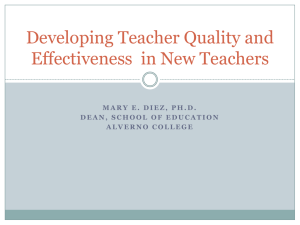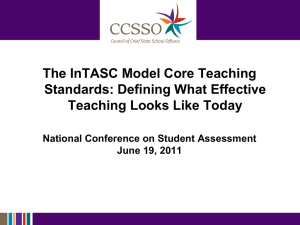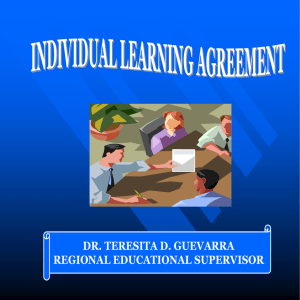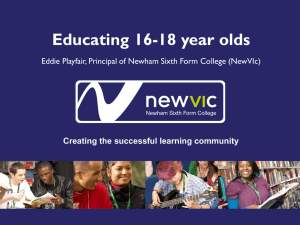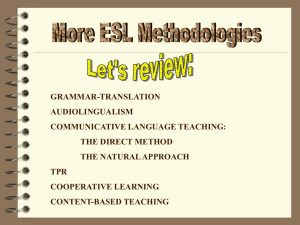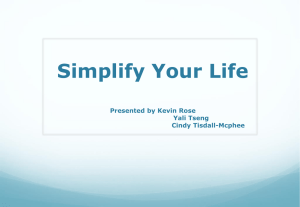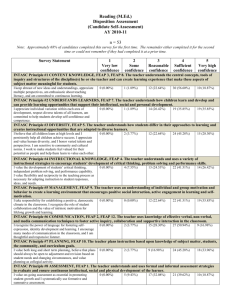CCSSO_PowerPoint - CCSSO State Consortium on Educator
advertisement
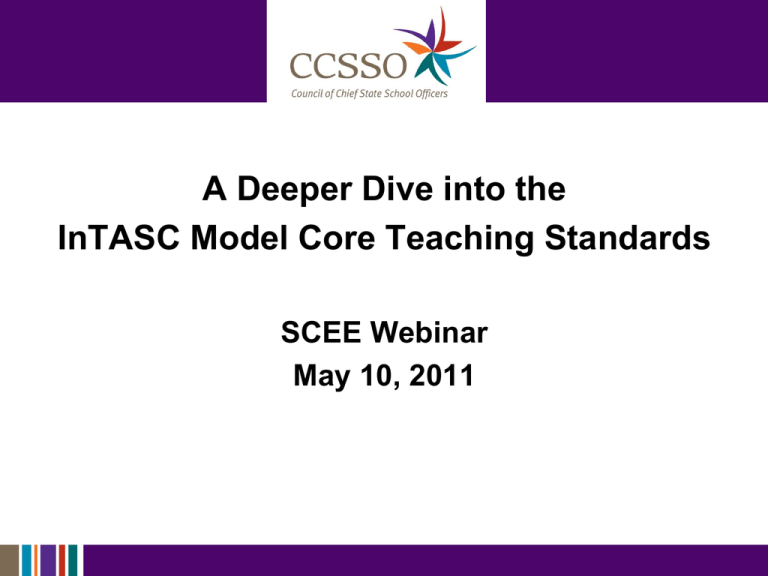
A Deeper Dive into the InTASC Model Core Teaching Standards SCEE Webinar May 10, 2011 Webinar Logistics Everyone is muted Use the chat function to make a comment or ask a question We will un-mute you to speak; you may press *6 to mute yourself again You may chat privately with individuals on your team If you have problems, you may send William Bentgen a message via chat or email at williamb@ccsso.org 2 Poll Poll Did you attend the InTASC sessions at the SCEE National Summit or watch the video of the session online? 1. Yes 2. No How many people are watching the webinar with you? 1. Just me 2. Me and 1 other 3. Me and 2-5 others 4. Me and more than 5 others (Many members had seen the Summit presentation; a few had more than one person with them in the room) 4 SCEE Framework 6 7 Presenters Kathleen Paliokas, Director, InTASC Lynne Cook, Professor of Special Education, California State University, Dominguez Hills Carlene Kirkpatrick, Instructional Coach, Dekalb County Schools (NBCT) Mary Diez, Education Dean, Alverno College Karen Huffman, Associate Director, ARCC at Edvantia Peter McWalters, Consultant, CCSSO Linda Alder, Coordinator, Educator Quality, Utah State Office of Education Kathy Meeks, Division of Educator Quality and Leadership, South Carolina Department of Education Key Changes to the 1992 Standards Developmental Continuum: Standards no longer just for beginning teachers but ALL teachers. INTASC becomes InTASC (Interstate Teacher Assessment and Support) A Focus on 21st Century Knowledge and Skills: Problem solving, curiosity, creativity, innovation, communication, interpersonal skills, the ability to synthesize across disciplines, global literacy, ethics, and technological expertise. Personalized Learning for Diverse Learners: Teachers need knowledge and skills to customize learning for learners with a range of individual differences. Key Changes to Standards (continued) Increased Emphasis on Assessment Literacy: Teachers need to have greater knowledge and skill around how to develop a range of assessments and how to use assessment data to improve instruction and support learner success. A Collaborative Professional Culture: Teaching is no longer a private act. New Leadership Roles for Teachers and Administrators: A shift in leadership from teachers working autonomously in their classrooms to administrators, teachers, and others sharing leadership roles and responsibilities for student learning. Groupings of Standards The Learner and Learning Standard #1: Learner Development Standard #2: Learning Differences Standard #3: Learning Environments Content Knowledge Standard #4: Content Knowledge Standard #5: Application of Content Groupings of Standards Instructional Practice Standard #6: Assessment Standard #7: Planning for Instruction Standard #8: Instructional Strategies Professional Responsibility Standard #9: Professional Learning and Ethical Practice Standard #10: Leadership and Collaboration Standard #1: Learner Development The teacher understands how learners grow and develop, recognizing that patterns of learning and development vary individually within and across the cognitive, linguistic, social, emotional, and physical areas, and designs and implements developmentally appropriate and challenging learning experiences. Standard #2: Learning Differences The teacher uses understanding of individual differences and diverse cultures and communities to ensure inclusive learning environments that enable each learner to meet high standards. Emphasis on Diverse Learners Diverse abilities and learning needs ALL learners– “each” and “every” Inclusive learning environment Teacher collaboration Plan and deliver instruction Make accommodations Support student learning Diverse Learners and Learning Differences Diverse learners and students with learning differences are those who, because of gender, language, cultural background, differing ability levels, disabilities, learning approaches, and/or socioeconomic status may have academic needs that require varied instructional strategies to ensure their learning. Learning Differences Learning differences are manifested in such areas as differing rates of learning, motivation, attention, preferred learning modalities, complexity of reasoning, persistence, foundational knowledge and skills, and preferred learning and response modes. Illustrations from Standard 2: Learning Differences 2(b) The teacher makes appropriate and timely provisions (e.g., pacing for individual rates of growth, task demands, communication, assessment, and response modes) for individual students with particular learning differences or needs. 2(h) The teacher understands students with exceptional needs, including those associated with disabilities and giftedness, and knows how to use strategies and resources to address these needs. 2(l) The teacher believes that all students can achieve at high levels and persists in helping each student reach his/her full potential. Standard #3: Learning Environments The teacher works with others to create environments that support individual and collaborative learning, and that encourage positive social interaction, active engagement in learning, and self motivation. Standard #4: Content Knowledge The teacher understands the central concepts, tools of inquiry, and structures of the discipline(s) he or she teaches and creates learning experiences that make these aspects of the discipline accessible and meaningful for learners to assure mastery of the content. Standard #5: Application of Content The teacher understands how to connect concepts and use differing perspectives to engage learners in critical thinking, creativity, and collaborative problem solving related to authentic local and global issues. InTASC Teaching Standards Linked to Common Core Student Standards CCSS Mathematics InTASC Teaching Standards Standard 5: Standard #6: Assessment The teacher understands and uses multiple methods of assessment to engage learners in their own growth, to monitor learner progress, and to guide the teacher’s and learner’s decision making. Standard #7: Planning for Instruction The teacher plans instruction that supports every student in meeting rigorous learning goals by drawing upon knowledge of content areas, curriculum, cross-disciplinary skills, and pedagogy, as well as knowledge of learners and the community context. Standard #8: Instructional Strategies The teacher understands and uses a variety of instructional strategies to encourage learners to develop deep understanding of content areas and their connections, and to build skills to apply knowledge in meaningful ways. Standard #9: Professional Learning and Ethical Practice The teacher engages in ongoing professional learning and uses evidence to continually evaluate his/her practice, particularly the effects of his/her choices and actions on others (learners, families, other professionals, and the community), and adapts practice to meet the needs of each learner. Standard #9: Professional Learning and Ethical Practice The teacher: Takes responsibility for student learning and engages in ongoing professional learning to improve planning and practice Uses a variety of data to evaluate teaching outcomes and to adapt planning and practice Reflects on personal biases and uses knowledge of learner differences to build stronger relationships and to create more relevant learning experiences Advocates, models and teachers safe, legal, and ethical use of information and technology Standard #10: Leadership and Collaboration The teacher seeks appropriate leadership roles and opportunities to take responsibility for student learning, to collaborate with learners, families, colleagues, other school professionals, and community members to ensure learner growth, and to advance the profession. Standard #10: Leadership and Collaboration The teacher: Takes responsibility for contributing to and advancing the profession by leading and by collaborating Contributes to a culture that supports high expectations for student learning using technological tools and other strategies to build local and global learning communities Takes on leadership roles at the school, district, state, and/or national level and advocates for learners, the school, the community, and the profession Takes an active and collaborative role in planning and jointly facilitating learning to meet the diverse needs of all learners Policy Implications 31 Policy Implications Preparation Recruitment Program approval • Program • Clinical practice • Performance assessment Licensure Initial Tier II(professional) Master (NBPTS) Policy Implications Growth Opportunities and Support Quality PD Continuous improvement Collegial responsibility Evaluation Teacher and leader Performance based Multiple measures Support/consequences Policy Implications Roles Career ladders Incentives Salary structures Levers: State/District/School Law Regulation Guidelines Incentives Capacity building Flexibility Utah State Office of Education Utah State Board of Education Constitution of Utah Article X Section 3. State Board of Education The general control and supervision of the public education system shall be vested in a State Board of Education. The membership of the board shall be established and elected as provided by statute. The State Board of Education shall appoint a \State Superintendent of Public Instruction who shall be the executive officer of the board. Utah State Office of Education Utah Effective Teaching Standards The Learner and Learning Standard 1: Learner Development Standard 2: Learning Differences Standard 3: Learning Environments Instructional Practice Standard 4: Content Knowledge Standard 5: Assessment Standard 6: Instructional Planning Standard 7: Instructional Strategies Professional Responsibility Standard 8: Reflection and Continuous Growth Standard 9: Leadership and Collaboration Standard 10: Professional and Ethical Behavior Project Phases Teaching Standards Work Group Educational Leadership Standards Work Group Common Guiding Principles Describes the overarching principles that guide policy, performance, and evaluation. Teaching Standards, Performance Expectations, and Indicators Describes the knowledge, skills, and dispositions necessary to teach the Common Core. Includes Essential Knowledge and Critical Dispositions to further define teaching practice. Accompanying rubric defines levels of performance toward the observable actions described by the indicators. May be used for both formative and summative purposes. Establishes minimum attainment for Level 1 and Level 2 performance. Educational Leadership Standards, Performance Expectations, and Indicators Describes the knowledge, skills, and dispositions necessary to provide leadership for schools and educational programs to support school cultures leading to successful teaching of the Common Core. Defines levels of performance toward the observable actions described by the indicators. May be used for formative and summative purposes. Establishes expectations for educational leadership preparation and practice. Evaluation System Framework Defines minimum requirements for educator evaluation programs. Includes a state model, professional development, tools, and other implementation support. Comprises State Board policy for educator evaluation programs. Effectiveness Project Tools Professional Development Model Evaluation Plan Licensing Requirements Evaluation Instruments Formative and Summative Instruments Alignment With Common Core Mentoring and Induction Models Alternative Preparation Programs Additional Development Teach Leader Area of Concentration or Endorsement Requirements for University Preparation Programs Utah Continuum of Professional Practice Use of the InTASC Standards in SC South Carolina is reviewing the InTASC standards See South Carolina’s PowerPoint slides “Use of InTASC Standards in SC – May 2011.pptx” on the SCEE collaboration site at http://scee.groupsite.com/page/webinars Discussion Questions How will your state use the updated InTASC standards? What additional resources or tools related to the updated standards would you find useful? Coming Up May 17, 2:00-3:30 pm EDT Rural Affinity Group Webinar June 14, 2:00-3:30 pm EDT Monthly Webinar TBA July 12, 2:00-3:30 pm EDT Monthly Webinar TBA 40 Poll Would you take part in a webinar that went even deeper into an individual standard? Definitely yes -- Probably no Probably yes -- Definitely no Would you take part in a webinar that went even deeper into an individual policy lever? Definitely yes -- Probably no Probably yes -- Definitely no (Participants indicated a stronger interest in learning more about the policy levers) Thank you!

